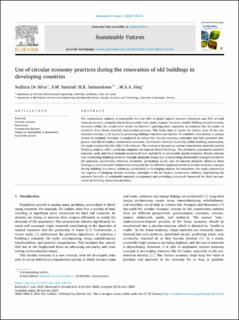| dc.contributor.author | Silva, Sudhira | |
| dc.contributor.author | Samarakoon, Samarakoon Mudiyansele Samindi | |
| dc.contributor.author | Haq, M.A.A. | |
| dc.date.accessioned | 2023-11-15T08:05:10Z | |
| dc.date.available | 2023-11-15T08:05:10Z | |
| dc.date.created | 2023-11-14T12:05:37Z | |
| dc.date.issued | 2023 | |
| dc.identifier.citation | De Silva, S., Samarakoon, S. S. M., & Haq, M. A. A. (2023). Use of Circular economy practices during the renovation of old buildings in developing countries. Sustainable Futures, 100135. | en_US |
| dc.identifier.issn | 2666-1888 | |
| dc.identifier.uri | https://hdl.handle.net/11250/3102611 | |
| dc.description.abstract | The construction industry is responsible for over 30% of global natural resource extraction and 25% of solid waste production, primarily due to its prevalent "take, make, dispose" economic model. Shifting toward a circular economy within the construction sector has become a pressing need, especially in countries like Sri Lanka, to transition from linear material consumption patterns. This study aims to assess the current state of the construction industry in Sri Lanka by presenting findings from two case studies. To establish a foundation, a concise review of pertinent literature is conducted to outline key circular economy principles and their potential integration into the Sri Lankan construction processes. To evaluate material circularity within building construction, the study employs the One-Click LCA software. The analysis is focused on various construction materials used in building projects, with a particular emphasis on concrete frame buildings. The circularity assessment considers concrete, steel, and brick elements in terms of their end-of-life or serviceable period scenarios. Results indicate that maximizing building retention through adaptable design and incorporating disassembly strategies in end-of-life processes significantly enhances circularity, particularly in the case of concrete elements. Based on these findings, a comprehensive framework is proposed for the effective implementation of circular economy concepts during building renovation initiatives, particularly in developing nations. In conclusion, this study underscores the urgency of adopting circular economy principles in the Sri Lankan construction industry, highlighting the potential benefits of sustainable material management and providing a practical framework for their incorporation in building renovation practices. | en_US |
| dc.language.iso | eng | en_US |
| dc.publisher | Elsevier | en_US |
| dc.rights | Navngivelse 4.0 Internasjonal | * |
| dc.rights | Navngivelse 4.0 Internasjonal | * |
| dc.rights | Navngivelse 4.0 Internasjonal | * |
| dc.rights.uri | http://creativecommons.org/licenses/by/4.0/deed.no | * |
| dc.title | Use of circular economy practices during the renovation of old buildings in developing countries | en_US |
| dc.title.alternative | Use of circular economy practices during the renovation of old buildings in developing countries | en_US |
| dc.type | Peer reviewed | en_US |
| dc.type | Journal article | en_US |
| dc.description.version | publishedVersion | en_US |
| dc.rights.holder | © The Author(s) 2023 | en_US |
| dc.subject.nsi | VDP::Samfunnsvitenskap: 200 | en_US |
| dc.source.volume | 6 | en_US |
| dc.source.journal | Sustainable Futures | en_US |
| dc.identifier.doi | 10.1016/j.sftr.2023.100135 | |
| dc.identifier.cristin | 2196397 | |
| cristin.ispublished | true | |
| cristin.fulltext | original | |
| cristin.qualitycode | 1 | |

